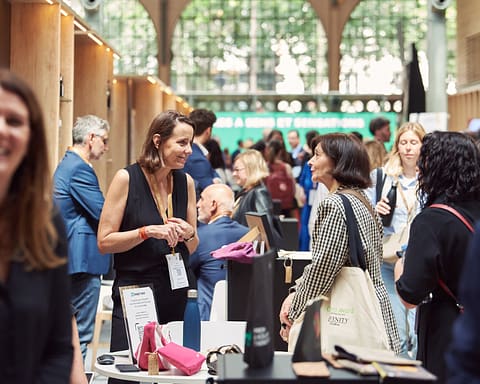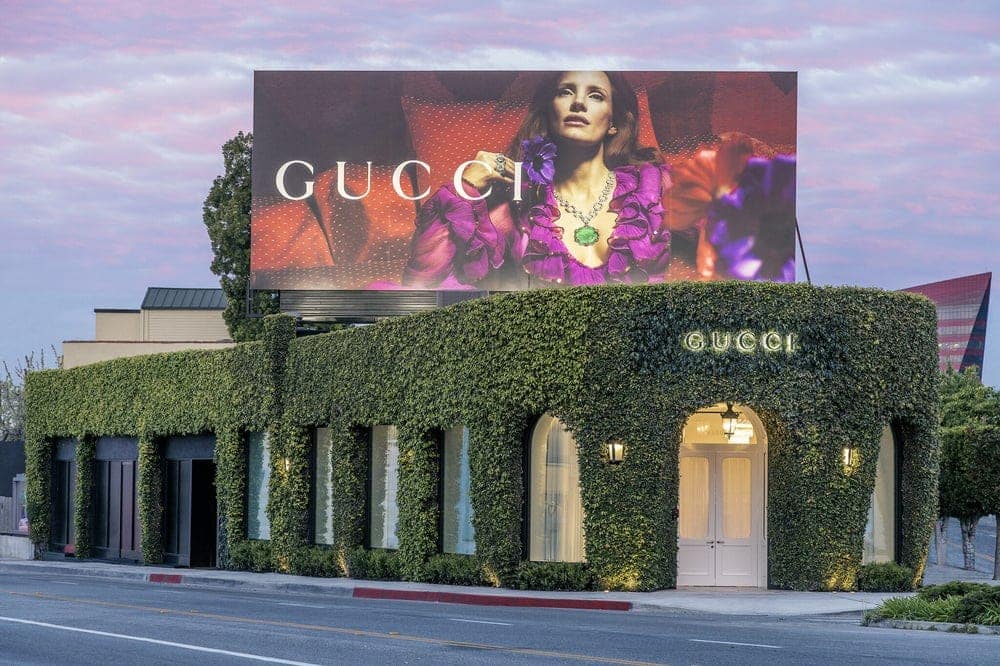As part of its rise to luxury, the House of Gucci unveils its new physical retail concept, exclusively reserved for its most affluent customers. The Italian brand has chosen the City of Angels and its geographical proximity to Hollywood’s dream factory to carry out this very first establishment.
An apartment more than a boutique
Gucci has just opened a new physical retail concept at the intersection of Melrose Place and Melrose Avenue in Los Angeles. Like Miami, New York and Austin, Los Angeles is a city where luxury goods shopping is concentrated in the US.
This busy shopping area in West Hollywood is one of the city’s busiest shopping districts. Its next-door neighbors include Balmain, The Row, Oscar de la Renta and Chloé.
The Italian brand didn’t choose the location randomly for this first showcase: with its entirely planted frontage, the place is well known in Hollywood. Occupied since 2005 by a Marc Jacobs boutique, it has been the setting for sumptuous parties. Gucci has owned the place since spring 2022 and presented its Gucci x Adidas pop-up store there.
While the giant billboard on the roof is visible to all, its doors are only open to VIP clients, exclusively by appointment. It is possible to have a personalized appointment for two, three, or four hours or even to privatize the store for the day.
Customers can enjoy a special menu from the Gucci Osteria restaurant on Rodeo Drive or have red-carpet fittings right on site.
The space is entirely modular. The racks can be temporarily stored to transform the space into a jewelry or watch store. The personalization of the relationship thus influences even the configuration of the boutique.
Finally, interior design is an ode to the golden age of Hollywood, as much as a nod to the first boutique of the house in Los Angeles opened in 1968.

To achieve this, the House called on a long-time collaborator: Gideon Ponte. Designer of sets for the cinema (American Psycho, Buffalo 66, Nacho Libre…) and Gucci campaigns since the Tom Ford period, he fitted out the 4380 m² space with furniture found worldwide.
There is soft carpeting, bamboo chairs covered in velvet, art-deco crystal chandeliers, mirrored columns, and a huge orange lacquered dining table. Purple and red suede curtains decorate the fitting rooms.

The House’s collections are not to be outdone, notably by highlighting dresses seen on the red carpets. Examples include the silver crystal and embroidered sequin gown worn by actress Jessica Chastain at the last Academy Awards and Dakota Johnson’s crystal fringed gown at the Venice Film Festival in 2021.
A concept on the way to internationalization
This Gucci Salon is the materialization of Kering’s project around private boutiques. These physical points of sale, distinct from the “general public” points of sale, were unveiled by the group’s chairman, François-Henri Pinault, last February. The entry ticket for an outfit does not go below 40,000 dollars, culminating in more than 3 million dollars for high jewelry pieces.
Nine permanent and temporary exhibitions are already planned in New York, Paris, Milan, London, Dubai, Hong Kong, Shanghai, Taipei and Tokyo.
The concept integrates a “glocal” strategy in its boutique design and in its product offering, aligned with the geographical and cultural framework of the outlet’s location.
Quiet luxury & HWNI: safe havens for uncertain times
If Gucci is focusing on its best customers, millionaires, it is to compensate for the drop in its sales in the last three months of 2022, during which it was hit by forced confinements in China and a loss of desirability on American soil, which had become more than ever the reactor core of the luxury industry. A situation due to its less spendy customers falling under the aspirational buyers. According to the latest Bain study, published in January 2023, the latter have been led to increase their arbitrages due to inflation to luxury brands’ detriment.
Much more immune, the high net-worth individuals (HNWI) and the ultra-high-net-worth individuals (UHWNI) are the most reliable growth drivers in these times of crisis. It is these privileged client segments with more than $1 million in liquid assets and investable assets of more than $30 million, respectively, that the Kering Group is targeting through its Gucci Salons.
The white paper from the Luxury Institute consulting firm states that while UHWNIs represent only 20% of the luxury brands’ customer base, they are responsible for 70% of high-end sales to these same brands.
The Gucci Salon is also part of the quiet luxury trend, the propensity of luxury clients to prefer more discreet outfits – meaning no logo – but no less luxurious in times of crisis. More generally, it is a question of not being noticed either by one’s appearance or by one’s behavior.
Regarding fashion, quiet luxury consists of adopting a chameleon-like dress that could easily pass for a fast fashion brand like Uniqlo.
This is the approach to self-preservation as well as self-assertion that the Roy family follows in Succession, the HBO series, favoring brands like Ermenegildo Zegna and Brunello Cucinelli.

Brought back to the Gucci Salon in Los Angeles, the space offers a glamorous and “voyeuristic” spirit that recalls the cinematographic universe of David Lynch, somewhere between Mulholland Drive (2001) and Blue Velvet (1986). Here, the customer is invisible from the street, thanks to tinted windows, but can, at leisure, scan the street without being seen.
In a period of transition since the arrival of its new designer Sabato De Sarno, the House of Gucci has not totally abandoned the maximalist and baroque spirit of Alessandro Michele’s collections, to the point of making it a sanctuary in the hushed surroundings of its Gucci Salon.
Read also > Gucci creates the first circular platform for luxury in Italy
Featured photo: © Gucci































